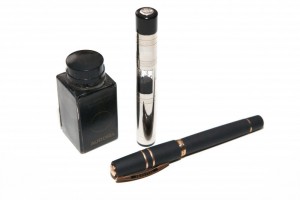
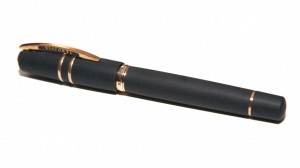
The Homo Sapiens pen uses a power filler system which means that there is an internal reservoir for the ink. Ink is loaded into the pen by unscrewing and retracting the filler mechanism, inserting the nib into a bottle of ink, and then plunging the power filler while trying not to spill anything. At the very least, my attempts at this procedure resulted in ink all over the section of my nice new pen. At worst, profanity, wasted ink, paper towels and lots of running water. After one such fill, I thought, there has to be a better way.
A fountain pen is composed of multiple parts or assemblies. Those parts may include, depending on model and configuration, the cap, the barrel, the nib, the feed, and the section. The section is the part of the pen in which the nib and feed are connected to the rest of the pen. It is generally the part of the pen that you might call the grip.
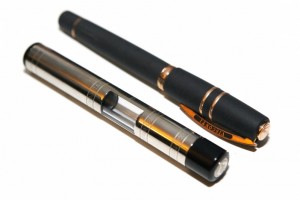
The tube has a removable stopper on one end that is sealed in the tube by a relatively strong rubber seal. Once the stopper is removed, my Homo Sapiens fountain pen slides in and is held tightly by the same seal. This seal keeps the ink neatly within the ink pot, both when sealed by the stopper, and when sealed by a pen. The seal is very tight, and I have to gently, but firmly, twist both items in order to remove them from the tube.
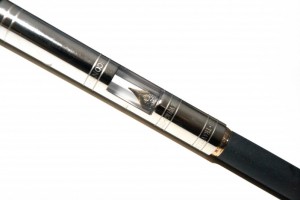
The instructions recommend that the first use of this device should be done with water. Apparently if you’re not careful, the ink pot can go shooting across the room, spraying ink as the fuel/exhaust mixture is expelled from the nozzle of newly created rocket. Since such a spectacle would be worthy of an article unto itself, I opted to forgo the water test and went straight for the full-blown ink test.
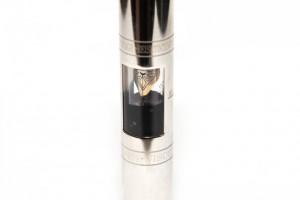
Luckily I had read numerous other reports online of humorous and messy results, so I knew to hold on to the pen and ink pot tightly. I was tempted to think I was smarter than those who had travelled this path before me, and thought that I could just keep the ink pot firmly on the desk while pumping downward. I quickly realized that such an effort would be fruitless because there is an additional step in the process. The ink port and pen must first be inverted before the pen will take ink.
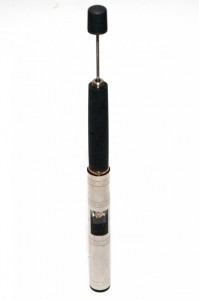
With the pen and ink pot inverted, I held them together tightly with one hand and plunged the power filler three times, letting the pen pull in ink for a 10-15 seconds after each stroke. Not a drop of ink was spilled. I could see bubbles emanating from the pen, which led me to believe that ink was indeed being pulled in by the filling system. After I was done, I righted the mated pair, and let it sit for a few seconds in the hope that any extra ink would drip off of the nib. After slowly twisting the pen out of the ink pot, I replaced the stopper and put the pen down for one final picture.
In the last picture, you can see the nib and section after I filled the pen with the Visconti Traveling Ink Pot. I did not clean or dab the nib at all before taking this picture. If you zoom in by clicking on the image, you can see how far up the section the ink went. From filling the ink pot with an eye-dropper, to filling the pen with ink, I completed the entire operation without spilling a drop. Without using a rag, paper towel, sponge or blotting paper, I filled my pen without getting any ink on my hands. Imagine filling a piston-type fountain pen without getting ink anywhere but in the pen.
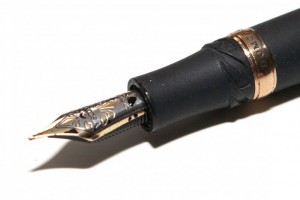
Donate: PayPal Crypto:
ETH: 0x0AC57f8e0A49dc06Ed4f7926d169342ec4FCd461
Doge: DFWpLqMr6QF67t4wRzvTtNd8UDwjGTQBGs

Thanks for your review. I have been thinking of buying one of these things for some time now, and your review has clinched it.
I too recently bought a homo sapiens and I totally love it. It replaced my Pelikan as my go to favorite.
I’ve used only fountain pens for decades now. I got my first good pen 30 years ago, and they’re all I use now. I can’t even write with a ballpoint any more.
The Visconti Traveling Ink Pot claims to work fine for filling pens with pistons too, but the price tag has stopped me so far from buying one.
Bottled ink always has big spill potential, no matter what carries it. if all you have to write with is a fountain pen, it won’t be of much use if you have no ink to fill it with when you reach your destination.
Fountain pens are like guitars to me; once I own a good one, I aways want another one.
So I have several pens now that are as expensive as your Homo sapiens. When I travel, I seldom take my favorite guitar with me, nor do I put my favorite pen in my pocket.
Cartridges are still the cleanest and easiest way to fill a fountain pen on the road. So when I’m packing, my best pens stay home, and I travel with an old $15.00 Shaeffer that writes reliably, even though not as smoothly, with some cartridges packed in a zip-seal baggie.
I’m attached to it now, after so many years, but it wouldn’t break my heart if I ever lost it. It’s a safer and cheaper alternative to a $75.00 ink pot.